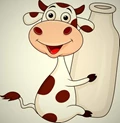
The purpose of India's National Milk Day is to commemorate the birthday of Dr. Verghese Kurien, who is regarded as the pioneer of the White Revolution in that country. The "Milkman of India" is another name for him. In order to increase milk production in the nation, Dr. Kurien, the man who is credited for starting the White Revolution in India, introduced "Operation Flood”.
Operation Flood was carried out in the subsequent stages:
-
The World Food Programme received funding for Phase I (1970–1981) from the sale of butter oil and skim milk powder given by the European Union (formerly the European Economic Community).
-
Urban markets doubled the number of milk outlets to 290 during Phase II (1981–1985), which saw an increase in milk sheds from 18 to 136. A self-sustaining network of 43,000 village cooperatives with 4,250,000 milk producers had been established by the end of 1985.
-
During Phase III (1985–1996), dairy cooperatives were able to improve and extend the infrastructure needed to acquire and sell rising milk quantities. 30000 additional dairy cooperatives were added during this phase, bringing the total to 73000.
Leading milk and dairy organizations in India, including the IDA (Indian Dairy Association), the NDDB (National Dairy Development Board), and 22 state-level milk federations, decided to designate November 26 as National Milk Day. Dr. Kurien's efforts are honored on National Milk Day, and people are informed about the health advantages and nutritional worth of milk.
About The “Father of White Revolution” Dr. Verghese Kurein
Born on November 26, 1921, in Kozhikode, Kerala with a native language was Malayalam Dr. Kurein attended the Diamond Jubilee Higher Secondary School in Erode for his education. During his higher studies, he received a government scholarship to study dairy engineering.
The "billion-litre concept" was developed by social entrepreneur Dr. Kurien. Dairy farming is now India's largest self-sustaining business and the one that generates the most significant number of jobs in villages thanks to Operation Flood.
The government gave Kurien one of its experimental creameries in Anand, Bombay, in 1949. Midway through his employment with the government, Kurien quit and founded Kaira District Cooperative Milk Producers' Union Limited (KDCMPUL) later also known as AMUL Dairy.
Birth of AMUL through the White Revolution
The seeds of this whimsical story were sown over 75 years ago in a small town in the western Indian state of Gujarat. The exploitative trade practices of local trade cartels sparked the cooperative movement. Angered by the unfair and manipulative practices of trade, the district's farmers turned to the great Indian patriot Sardar Vallabhbhai Patel for a solution. He advised them to move away from middlemen and set up their cooperatives to manage sourcing, processing, and marketing.
In 1946, local farmers went on a milk strike. Under the inspiration of Sardar Patel and the guidance of leaders such as Morarji Desai and Tribhuvandas Patel, they founded their cooperative in 1946.
This cooperative, Kaira District Cooperative Milk Producers Union Ltd., started with just two village dairy cooperatives and 247 litres of milk, and now he is better known as Amul Dairy. Amul has grown thanks to the inspirational leadership of its Founding Chairman, Tribhuvandas Patel, and the dedicated professionalism of Dr. Kurien In charge of the dairy since 1950, Verghese Kurien has gone from strength to strength.
The Indian Prime Minister at the time, Lal Bahadur Shastri, decided that the same approach should be the cornerstone of the nation's dairy development policy. He understood that Amul's success was due to four key factors. Farmers owned dairy farms, elected officials managed village and district associations, and hired professionals to run dairy farms and run businesses. Most importantly, the cooperatives were responsive to the needs of the farmers and responsive to their demands.
His initiative established the National Dairy Development Board with its foundation in 1965.
National Dairy Development Board
An Act of the Indian Parliament established the National Dairy Development Board (NDDB), which is a statutory organization. It is a property of the Indian government's Ministry of Fisheries, Animal Husbandry, and Dairy. Regional offices are located around the nation, with the main office being in Anand, Gujarat.
Indian Dairy Machinery Company Limited, Mother Dairy, and Indian Immunological Limited, both in Hyderabad, are divisions of NDDB. The Board was established to provide funding and assistance to organizations controlled and owned by producers. Its initiatives and programs promote national initiatives that foster the expansion of agricultural cooperatives and work to improve them. The board's activities are fundamentally based on cooperative values and tactics.
Impact of the White Revolution on the Indian Economy
The largest milk producer in the world right now is India. Milk production has increased by more than six times since independence. Moreover, now there is more milk accessibility per person per day.
The White Revolution was as important for the growth of the dairy sector as the Green Revolution was to the production of grains. Improved cow breeding practices and the use of new technology are the elements that influence the outcome.
Small and marginal farmers as well as landless laborers have mostly profited from the White Revolution. To ensure the success of the Operation Flood Program, research centers have been created in Anand, Mehsana, and Palanpur (Banaskantha). Three regional centers in Siliguri, Jalandhar, and Erode are also operational.
Through the National Milk Grid, Operation Flood made it possible for customers in 700 towns and cities to get high-quality milk. The scheme also assisted in eliminating intermediaries, which decreased seasonal price differences. Due to the cooperative framework, it was financially feasible for farmers to produce and distribute milk and milk products on their own.
In addition, it put an end to India's reliance on imported milk solids. The country began exporting milk powder to several international nations in addition to being able to cover its domestic dairy demands. Due to crossbreeding, milking animals' genetic improvement also improved. Around 10 million farmers began generating revenue from dairy farming as the dairy industry developed and grew.
















